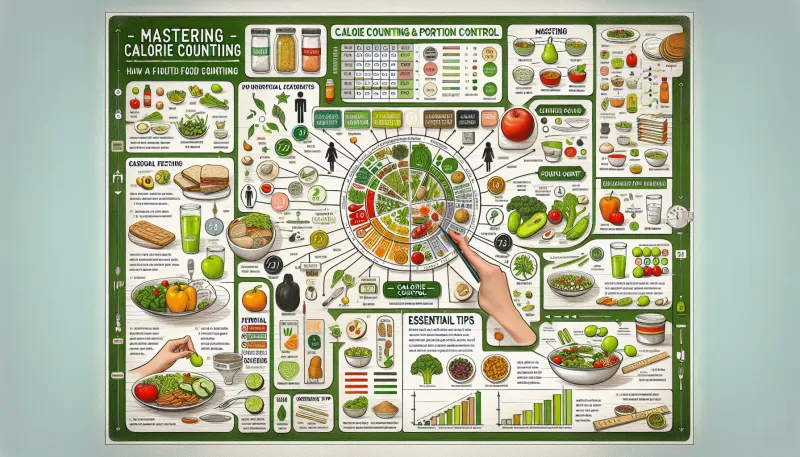Mastering Calorie Counting and Portion Control: A Comprehensive Guide

Unlock the secrets to effective calorie counting and portion control with our comprehensive guide. Learn expert tips and strategies to help you achieve your health and fitness goals.
Understanding calorie counting and portion control is essential for anyone looking to maintain a healthy diet and achieve their fitness goals. This comprehensive guide provides you with the expert knowledge, tips, and strategies you need to effectively manage your calorie intake and control portion sizes. Let’s delve into why these practices are important, how to implement them, and the benefits they offer.
Introduction
Managing weight and ensuring a balanced diet can often seem overwhelming, especially with the myriad of information available. Two fundamental practices that can significantly aid in this journey are calorie counting and portion control. By mastering these techniques, not only can you make informed dietary choices, but you can also create sustainable eating habits that support long-term health and well-being.
What is Calorie Counting?
Calorie counting involves tracking the number of calories you consume through food and beverages daily. Calories are units of energy, and understanding how much energy you are taking in versus how much you are expending is crucial for managing your weight. This method is highly effective for those looking to lose weight, gain weight, or simply maintain their current weight.
Why Calorie Counting is Important
Calorie counting is important because it enables you to:
- Achieve Weight Goals: Whether you aim to lose, gain, or maintain your weight, knowing your calorie intake helps you tailor your diet accordingly.
- Understand Your Eating Habits: Tracking your calories can reveal patterns in your eating behavior, such as overeating or under-eating.
- Improve Nutritional Awareness: It encourages you to make healthier food choices by being mindful of the caloric content of different foods.
How to Count Calories Effectively
Counting calories effectively involves several steps:
Determine Your Caloric Needs
Your daily caloric needs depend on various factors including age, gender, weight, height, and activity level. You can use online calculators or consult a nutritionist to determine your specific needs.
Track Your Intake
Use apps or food diaries to log everything you consume. Be meticulous about including all meals, snacks, and beverages.
Read Nutrition Labels
Nutrition labels on food packaging provide information on the calorie content. Familiarize yourself with serving sizes and the number of servings per package.
Use Measuring Tools
Utilize kitchen scales, measuring cups, and spoons to accurately measure portion sizes. This will ensure you are logging the correct number of calories.
What is Portion Control?
Portion control is the practice of controlling the amount of food you eat in one sitting. It involves being mindful of portion sizes to avoid overeating, which can lead to weight gain and other health issues.
The Importance of Portion Control
Portion control helps you:
- Manage Weight: By eating appropriate portions, you can prevent excessive calorie intake.
- Improve Digestion: Smaller, balanced portions can aid in better digestion.
- Maintain Energy Levels: Eating the right amount keeps your energy levels stable throughout the day.
Effective Strategies for Portion Control
Use Smaller Plates
Smaller plates can make portions look larger, helping you feel satisfied with less food.
Measure Your Food
Similar to calorie counting, use measuring tools to ensure you are serving appropriate portions.
Don’t Eat Directly from the Package
Instead, serve food onto a plate or bowl to keep portion sizes in check.
Listen to Your Body
Eat slowly, and pay attention to hunger and fullness signals. Stop eating when you are comfortably full, not overly stuffed.
Common Challenges and Solutions
Handling Cravings
Cravings can be challenging when trying to control portions or count calories. Distract yourself with activities, or opt for healthier alternatives.
Dining Out Tips
Restaurant servings are often larger than necessary. Consider sharing a meal, asking for a half portion, or taking half of your meal home.
Staying Consistent
Consistency is key. Make calorie counting and portion control part of your daily routine, and treat occasional indulgences as part of a balanced approach.
Tools and Resources
Calorie-Counting Apps
Apps like MyFitnessPal, Lose It!, and Cronometer make tracking intake easier and provide extensive databases of food items.
Portion Control Tools
Invest in portion control plates or containers that are designed to help you manage serving sizes.
Conclusion
Mastering calorie counting and portion control is a powerful strategy for achieving and maintaining a healthy lifestyle. By understanding and implementing these practices, you can make informed decisions about your diet, leading to better health outcomes. Start integrating these techniques into your daily routine, stay consistent, and enjoy the benefits of a balanced and mindful approach to eating.



























